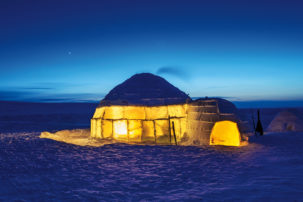When Ojibwe journalist and head of TIFF Cinematheque Jesse Wente was asked to program a work at the Ryerson Image Centre this fall, he immediately thought of Inuit filmmaker Zacharias Kunuk.
Though Kunuk is best known for his three-hour epic Atanarjuat: The Fast Runner (ᐊᑕᓈᕐᔪᐊᑦ)—winner of the Caméra d’Or at Cannes in 2001—he also makes short, lesser-seen video work that portrays Inuit life.
And mainland Canadians still have very little knowledge of Inuit peoples, Wente says. Thus, he commissioned Kunuk to make The Dog Team, a new video about an Inuit dog race, for the RIC. Wente felt it was important to show a different image of Canada there, on a screen that faced out into public space.
 Zacharias Kunuk, still from Dog Team, 2017. Video installation. Courtesy of the artist and Kinguliit Productions Inc.
Zacharias Kunuk, still from Dog Team, 2017. Video installation. Courtesy of the artist and Kinguliit Productions Inc.
“Maybe people can absorb that this is seeing Indigenous people living their lives as they have for millennia, largely undisturbed,” Wente says. “This is clearly a community event that many Canadians don’t even know exist. They do it absolutely traditionally: there’s no motorized assistance. They have to travel 500 kilometres, they have to take their own supplies. They have to care for the dogs on the journey.”
The seven-minute looped video of The Dog Team is set in a small Inuit town at the finishing line of a dog-sled race. It opens with a dog team travelling across an expansive mass of snow. The shot follows him as he nears a cheering community at the bottom of a slope dotted with colourful houses. Throughout the rest of the video, we see the arrival of several more lone sled racers and their dogs, each in turn crossing the frame towards the cheering crowd and then being hefted up on their sleds for a celebratory hurrah.
 Zacharias Kunuk, still from Dog Team, 2017. Video installation. Courtesy of the artist and Kinguliit Productions Inc.
Zacharias Kunuk, still from Dog Team, 2017. Video installation. Courtesy of the artist and Kinguliit Productions Inc.
The RIC’s display, which is viewable from a Ryerson campus square and Gould Street through a long window, is a set of eight screens arranged in two rows of four that form a single panoramic view. The expanded field of vision here evokes profound impressions of the vastness of the landscape, the solitude of the long, quiet journeys, and the fortitude of the dog sledders.
Kunuk’s work comes a bit later in the development of the Indigenous film history. He works as an video artist as well as a filmmaker. This sets him somewhat apart from other Inuit and Indigenous filmmakers.
“Zach worked entirely in the North and his work was mostly displayed in the North,” Wente explains. “Unfortunately it took Atanarjuat—the feature work that came almost 20 years into his career—for people to fully pay attention, even though he’s made some amazing work before then.” (Some of that early work, notably, was also about dog teams.)
 Zacharias Kunuk, still from Dog Team, 2017. Video installation. Courtesy of the artist and Kinguliit Productions Inc.
Zacharias Kunuk, still from Dog Team, 2017. Video installation. Courtesy of the artist and Kinguliit Productions Inc.
The Indigenous film community developed thanks to the three Mothers, Wente says: Merata Mita (Maori) in Aotearoa/New Zealand, Essie Coffey (Muruwari) in Australia and Alanis Obomsawin (Abenaki) in Canada. These women have been instrumental in making new and innovative films about Indigenous people.
In Canada specifically, alongside a proliferation of film festivals like TIFF and imagineNATIVE, this community was also helped by the National Film Board’s Challenge For Change program in the late 1960s. Shortly after, Obomsawin made her first film in early 1970s, and then Kunuk started making video in the 1980s.
 Zacharias Kunuk, still from Dog Team, 2017. Video installation. Courtesy of the artist and Kinguliit Productions Inc.
Zacharias Kunuk, still from Dog Team, 2017. Video installation. Courtesy of the artist and Kinguliit Productions Inc.
“What’s interesting about Zach’s cinema is his movies aren’t just movies—they’re also survival,” Wente says. “In the creation of his fictionalized work, he recreates clothing, igloos and other items. He constructs all of this and the community joins him, and they all do this exactly the way they’ve been doing it for hundreds and thousands of years.”
The timing of this work is crucial, too, says Wente.
“At a time when Indigenous cultures are under historic and ongoing pressure and attack, his movies actually are cultural preservation in and of themselves,” Wente says of Kunuk. And The Dog Team is no exception: “Here, he’s capturing in more documentary form exactly the same thing. Here’s a race that while it’s a race, it’s also preserving a way of life that was under attack.”









